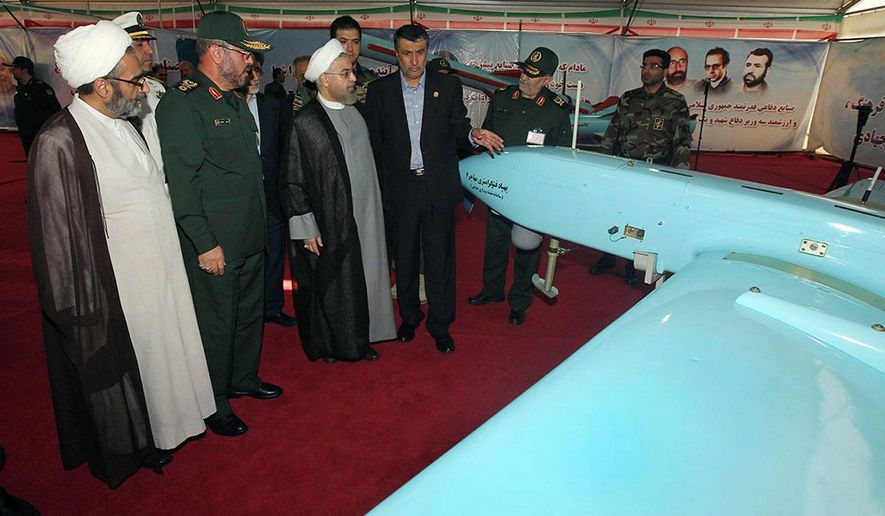Iran has placed an “explosive emphasis” in putting military surveillance and attack drones into the sky, including “suicide” aircraft that increase risks for Israel and for U.S. ships in the Persian Gulf, according to a new U.S. Army analysis.
The Iranian army is spearheading the drive for a fleet of explosive-mounted killer drones. It tested them in December against ship targets near the Strait of Hormuz, the chokepoint for maritime traffic in and out of the Gulf.
The implication is clear: The hard-line Shiite-dominated regime has long threatened to close the Strait of Hormuz, through which about 20 percent of the world’s oil is transported daily. The live-fire test/exercise shows that kamikaze drones are in the Iranian war plan.
Iran also is sharing new drone technologies with allies Hamas on Israel’s south and Hezbollah on its north, the Army study says. Both are U.S.-designated terrorist groups that pledge the destruction of Israel.
The assessment is contained in a new publication from the Army’s Foreign Military Studies Office at Fort Leavenworth, Kansas. The document, which contains assessments by several in-house national security analysts, is devoted to the topic of the growing use of military drones worldwide.
And Iran is no exception.
PHOTOS: See Obama's biggest White House fails
“While it is easy to dismiss the idea of a suicide drone as more symbolic than real in an age of cruise missiles and precise Predators, utilizing suicide drones is an asymmetric strategy which both allows Iran to compete on an uneven playing field and poses a risk by allowing operators to pick and choose targets of opportunity over a drone’s multi-hour flight duration,” said the Army assessment.
In all, it says, “Perhaps no aspect of Iran’s overt military program has seen as much development over the past decade as Iranian unmanned aerial vehicles Iran’s explosive emphasis on drone development promises to make American operations in both the Persian Gulf and Gulf Aden [at the Red Sea] more complicated and can also pose a proliferation concern should Iran export suicide drones to groups like Hezbollah or Bashar al-Assad loyalists in Syria.”
Iran’s drone technology is showing up with two of its proxies. In February, Hamas launched three Ababil-3 reconnaissance drones into Israeli airspace and then pulled them back once Israeli air defense fighters were launched. The unmanned aerial vehicles (UAVs) were produced in Gaza and can be equipped with miniature rockets.
Iranian-designed drones also have penetrated Israel in the north from Lebanon, Hezbollah’s base of operations.
Retired Air Force Lt. Gen. Thomas McInerney said the Iranian air force is no match for U.S. air power. But drones in sufficient numbers could still inflict damage similar to Japanese kamikazes in World War II.
“The results will be the same, but you only need a few to get through, so a significant potential threat,” Mr. McInerney said.
SEE ALSO: Inside the Ring: Pentagon prepares robots to fight wars
According to Iran’s semi-official FARS News Agency, Brig. Gen. Kioumars Heidari posed for a photograph, with a map of the Persian Gulf in the background, and said: “We tested three models of suicide unmanned aerial vehicles, which were a type of cruise missiles and have been fully manufactured by Iranian experts.”
Some of the Army Foreign Military Study Office’s assessments of drone expansion have been written by Michael Rubin, a contract analyst to the office and a scholar at the American Enterprise Institute.
Mr. Rubin told The Washington Times that suicide drones could be especially effective in the narrow Gulf waters, where it is more difficult for aircraft carriers to maneuver and where naval helicopters are frequently in the air.
“This makes the Iranian development of drones specifically to interfere with helicopter operations extraordinarily dangerous,” Mr. Rubin said. “The Iranians have long probed American ships’ defenses in international waters, but you can communicate with an Iranian boat. You can’t communicate with an Iranian drone, and so the slippery slope to a real military engagement has just gotten closer.”
He added that Iran has announced that it plans to ship drones to Hezbollah, whose fighters are in Syria defending the Assad regime. This means other clients, such as Houthi Shiites in Yemen and Iraqi Shiite militias in Iraq, also could receive suicide drones.
“That means not only will passenger aircraft be in danger in Israel and the Eastern Mediterranean, but the Bab al-Mandab [strait] off the Yemen coast just got inordinately more dangerous for anyone that comes through without guns blazing,” he said.
Such vehicles do not require the precision of launching a Hellfire missile from a U.S. Predator drone. An Iranian operator simply has to find a target on the video screen and drive the aircraft to it.
“Even absent explosives, an Iranian willingness to collide drones with helicopters and jet fighters could hamper routine naval and army aviation along the borders of Iran,” Mr. Rubin wrote in the Army publication.
• Rowan Scarborough can be reached at rscarborough@washingtontimes.com.




Please read our comment policy before commenting.